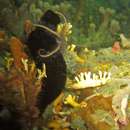en
names in breadcrumbs


Phallusia nigra is a solitary marine tunicate of the ascidian class found in tropical seas around the world. It usually lives in shallow waters, attached to any hard substrate.[2][3]
Like all tunicates, P. nigra has a thick leathery envelope (tunic) containing cellulosic material. Like all solitary ascidians, the tunic encloses a sac-shaped body with separate water entrance and exit tubes (siphons). It lives on plankton that it filters from seawater with a mucous net. This tunicate is often host to the small symbiotic pea crab Tunicotheres moseri which takes up residence in its atrial chamber.[4]
An adult P. nigra may be 10 cm (4 in) long. The tunic is usually velvet black or dark brown, but may be gray in specimens that are younger or live in shaded areas. Its original range is unclear; the tropical Western Atlantic Ocean, the Red Sea, and the Indian Ocean have been proposed.[2]
The tunic of P. nigra contains many vesicles filled with a strong acid (with pH near 1), containing mostly sulphate SO
42− and chloride (Cl−
) anions. The vesicles are concentrated towards the outer surface and are easily ruptured by contact; they are believed to protect the animal from predation and fouling.[5]
Substances extracted from the dried tunic with methanol have been found to have cytotoxic, antibacterial, antipyretic, analgesic, and histamine-like activity.[6][7][8]
Phallusia nigra is a solitary marine tunicate of the ascidian class found in tropical seas around the world. It usually lives in shallow waters, attached to any hard substrate.
Like all tunicates, P. nigra has a thick leathery envelope (tunic) containing cellulosic material. Like all solitary ascidians, the tunic encloses a sac-shaped body with separate water entrance and exit tubes (siphons). It lives on plankton that it filters from seawater with a mucous net. This tunicate is often host to the small symbiotic pea crab Tunicotheres moseri which takes up residence in its atrial chamber.
An adult P. nigra may be 10 cm (4 in) long. The tunic is usually velvet black or dark brown, but may be gray in specimens that are younger or live in shaded areas. Its original range is unclear; the tropical Western Atlantic Ocean, the Red Sea, and the Indian Ocean have been proposed.
The tunic of P. nigra contains many vesicles filled with a strong acid (with pH near 1), containing mostly sulphate SO
42− and chloride (Cl−
) anions. The vesicles are concentrated towards the outer surface and are easily ruptured by contact; they are believed to protect the animal from predation and fouling.
Substances extracted from the dried tunic with methanol have been found to have cytotoxic, antibacterial, antipyretic, analgesic, and histamine-like activity.
Phallusia nigra is een zakpijpensoort uit de familie van de Ascidiidae.[1] De wetenschappelijke naam van de soort is voor het eerst geldig gepubliceerd in 1816 door Savigny.[2]
De soort komt voor in tropische zeeën over de hele wereld. Savigny meldde dat ze voorkwam in de Rode Zee. Ze leeft in ondiep water en hecht zich op hard substraat zoals rotsen of schelpen.
Bronnen, noten en/of referenties